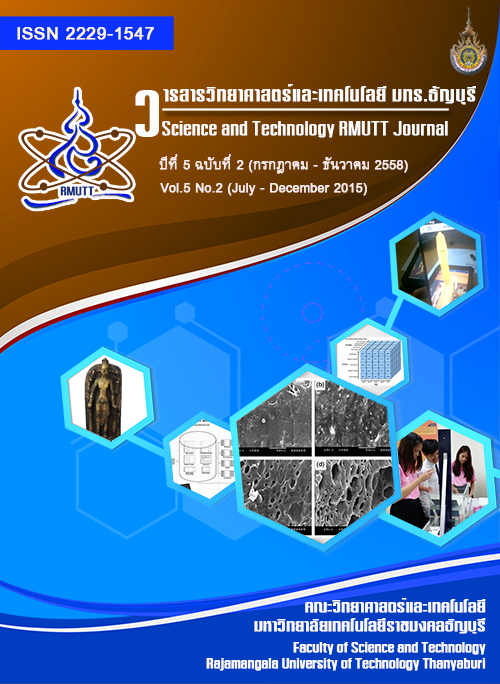Recovery of Arm Control for Stroke Patients using Depth Sensor with a Game-Based Approach
Main Article Content
Abstract
This paper presents a rehabilitation system for arm control recovery in stroke patients by using a depth sensor. The objective is to support the rehabilitation process for arm and hand control via a jigsaw puzzle game. The game is designed as a color matching game. The patient has to grasp and move the jigsaw pieces as seen on the computer monitor to the corresponding colors in the specified places. There are two sizes of the game, including the 2x2 and the 3x3 game. Each game size has two levels that are the ‘Easy’ and the ‘Hard’ level. The patient’s arm movement is not exceed the distance of 18 and 30 centimeters for the ‘Easy’ and the ‘Hard’ level, respectively. The system collects the patient’s gaming data in the last three times. So, the physical therapist can assess the patient’s progress by using the data. The system consists of 3 modules, including the Device Module, the Game Module, and the Data Collection Module. The system has been tested with a real patient. The result shows that after the training phase he can play the developed game successfully. After more improvement, the developed system can be used to support the rehabilitation activity with more attractive to the patients that are related to the arm and hand movement.
Article Details
References
สำนักนโยบายและยุทธศาสตร์ กระทรวงสาธารณสุข. สรุปสถิติที่สำคัญ พ.ศ. 2557. นนทบุรี : สำนักงานกิจการโรงพิมพ์องค์การสงเคราะห์ทหารผ่านศึก ในพระบรมราชูปถัมภ์. 2557.
วิชัย เอกพลากร และสมเกียรติ แสงวัฒนาโรจน์ (บรรณาธิการ). สะกดรอยปัจจัยเสี่ยงโรคหัวใจและหลอดเลือด. กรุงเทพฯ : มูลนิธิสาธารณสุขแห่งชาติ. 2550.
ทีมสหสาขาวิชาชีพ ศูนย์สมเด็จพระสังฆราชญาณสังวรเพื่อผู้สูงอายุ. คู่มือการดูแลผู้ป่วยโรคหลอดเลือดสมองระยะฟื้นฟู ฉบับผู้ป่วยและผู้ดูแล. ศูนย์สมเด็จพระสังฆราชญาณสังวรเพื่อผู้สูงอายุ จังหวัดชลบุรี กรมการแพทย์ กระทรวงสาธารณสุข. ชลบุรี. 2554.
E. Davaasambuu, C.C. Chiang, J.Y. Chiang, Y.F. Chen, and S. Bilgee. “A Microsoft Kinect based virtual rehabilitation system”. in Proc. of the 5th International Conference (FITAT 2012). (2012): 44-50.
C.-J. Su. “Personal rehabilitation exercise assistant with kinect and dynamic time warping”. International Journal of Information and Education Technology. (2013): 448–454.
N.M. Khan, S. Lin, L. Guan, and B. Guo. “A visual evaluation framework for in-home physical rehabilitation”. IEEE International Symposium on Multimedia (ISM 2014). (2014): 237-240.
C. Camporesi, M. Kallmann, and J.J. Han. “VR solutions for improving physical therapy”. in Proc. IEEE Virtual Reality. (2013): 77-78.
D. Anton, A. Goni, A.Illarramendi, J.J. Torres-Unda, and J. Seco. “KiReS: A Kinect-based telerehabilitation system”. in IEEE 15th International Conference on e-Health Networking, Applications & Services (Healthcom). (2013): 444- 448.
D. Webster, O. Celik. “Systematic review of Kinect applications in elderly care and stroke rehabilitation”. Journal of NeuroEngineering and Rehabilitation. 11(108) (2014): 1-21.
กิ่งแก้ว ปาจรีย์ (บรรณาธิการ). การฟื้นฟูสมรรถภาพผู้ป่วยโรคหลอดเลือดสมอง. กรุงเทพฯ : งานตำราวารสารและสิ่งพิมพ์ สถานเทคโนโลยีการศึกษาแพทยศาสตร์ คณะแพทยศาสตร์ศิริราชพยาบาล มหาวิทยาลัยมหิดล. 2550.
สถาบันประสาทวิทยา. แนวทางการฟื้นฟูสมรรถ-ภาพผู้ป่วยโรคหลอดเลือดสมอง. กรุงเทพฯ : สถาบันประสาทวิทยา กรมการแพทย์ กระทรวงสาธารณสุข. 2550.
S. Kean, J. Hall, and P. Meet the Kinect: An Introduction to Programming Natural User Interfaces. Berkely, CA: Apress; 2011.
J. Shotton, A. Fitzgibbon, M. Cook, T. Sharp, M. Finocchio, R. Moore, A. Kipman, and A. Blake. “Real-Time Human Pose Recognition in Parts from Single Depth Images”. CVPR '11 Proceedings of the 2011 IEEE Conference on Computer Vision and Pattern Recognition. (2011): 1297-1304.


